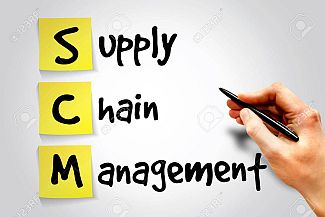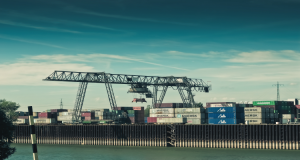We can define supply chain Management as the discipline that covers the end to end business activities carried out in any business, which is independent of the manufacturing or service sectors. Generally this is the only way today in which businesses need to be earned out so as to support and approve a win-win’ situation among the business partners concerned.
What is Supply Chain?
Supply chain is defined as a network of facilities and distribution options which performs the functions of procurement of materials, transformation of materials into intermediate and finished products, and thereby distribution of the finished products to final customers. In general, supply chains exist in both service and manufacturing organisations, even though the complexity of the chain may significantly vary from one industry to another industry.
Typically, supply chain management is considered to position between fully vertically integrated firms, where the material flow is owned by a single firm and those where each channel member operates independently. It therefore becomes important to have a coordination between the various players in the chain is key in its effective management. We can therefore observe and compare supply chain management to a well-balanced and well-practiced relay team.
Nature and Scope of SCM
Supply Chain Management focuses on the management relationship as a means of achieving better results for all members of Supply Chain, including the customers. Supply chain Management is the authority which involves all of the business activities from end to end, carried out in any industry, independent of the nature i.e. manufacturing or service nature of the company.
Companies can save a lot with a small percentage reduction in the cost of materials, its management and coordination efforts. Companies also want to share their suppliers the burden of flexibility and responsiveness to take care of varying customer demands, their timings and risk of product developmental efforts and costs involved.
*The capability required for market entrance and leadership has changed from ability to supply to ability to add more value to the customer. This situation can be regarded as the basic cause of evolution of supply chain management
Supply Chain Decision Phases
Supply Chain Design: Decisions regarding the configuration of the supply chain, the proper allocation of the resources and what processes each stage will perform are important. Decisions based on the company’s strategies like the locations of the warehouses, the manufacturing facilities, the production, the different modes of transportation to be used and the information systems to be used are equally critical.
During this phase it is very important for the company to configure their supply chain in accordance with the strategic objectives.
Supply Chain Planning: Since the configuration of the supply chain is fixed in the first phase, it is now time to design the configuration strategically. It is in this phase that an organisation gets its corporate strategy developed. As the configuration established involves constraints, it is important for the planning to be done within these constraints.
It is easy for an organisation to develop within a shorter time horizon with better forecasts and incorporate any flexibility in the supply chain design phase and try to improve its performance.
Supply Chain Operations: In Supply Chain Operations the time horizon is very short. Such that the organisation takes decisions on the strength of individual customer orders. In this case, the supply chain configuration set and the policies of the organisation are clearly defined. The primary objective of the phase is to handle the incoming customer’s order in the best possible way.
Supply Chain and The Replenishment cycle
Replenishment cycle is said to occur at the retailer and wholesaler interface. The replenishment cycle includes all the processes involved in updating and replenishment of inventory.
- Retail order trigger: The retailer has to prepare an ‘Ordering Policy’ and these triggers an order from the previous stage. The main objective is to maximise profitability by ensuring economies of scale and balancing product availability and inventory holding costs.
- Retail order entry: Here again like the customer order entry, this can be done electronically or by some other method, again inventory or production is allocated to fulfil the order.
- Retail order fulfilment: Here the order size is more than that ordered by a customer to a retailer. The chief objective in retail order fulfilment here is to supply the desired quantity on time and thereby minimise costs.
- Retail order receiving: This process involves the flow of products from the wholesaler to the retailer, the flow of information updates at the retailer and funds flow from the retailer to the wholesaler.
SCM and The Manufacturing Cycle
It involves the replenishment of the distributor’s inventory. This cycle is triggered by the customer’s order, the replenishment of the distributor’s inventory, or by the forecast of customer demand and also the availability of finished goods at the manufacturer’s warehouse.
- Order arrival: The distributor prepares a replenishment order based on the forecast for future demand and current product inventories.
- Product Scheduling: The forecasted orders are allocated to a production plan. The objective of this process is to maximise the fulfilment of orders in proportion while keeping lower costs.
- Manufacturing and shipping: During the shipping phase of this process, the product is transported to the customer, retailer and wholesaler or to the company’s own finished product warehouse.
- Receiving: In the process of receiving, the distributor receives the products and then he updates the inventory records.
SCM and The Procurement Cycle
In general, all the components and raw material necessary for the production process are ordered from suppliers for the concerned inventories replenished, such that these orders are made as per the production schedule.
The company needs to tailor it’s supply chain by sharing certain links in the supply chain with some products, while having separate operations for separate links. This helps to achieve maximum efficiency in terms of costs and responsiveness. For example, similar products are produced on the same production line and products that are required urgently are shipped by air for quicker delivery.
Product life cycles: Changes in the above factors lead to a change in the supply patterns due to maturity of the product and the introduction of sophisticated technology. Hi-tech products such as computers, laptops and mobile phones are prone or rather largely affected by these life cycle swings over a short period of time. Thus, a company needs to alter its supply chain strategy as and when a product moves from one phase to another.
Beginning stage (Introductory and growth stages):
• Uncertain demand and therefore unpredictable supply
• Higher margins and quick delivery
• Product availability necessary for capturing the market
• Costs are not first priority
Diminishing stage (Maturity and decline stages):
• Certain demand and predictable supply
• Less margins due to increased competition
• Price of the product is a significant factor for customer purchase
Time related competitive changes
As competitors flood the market with larger product varieties, customers become use to their needs being satisfied. So, companies are required to produce larger variety of products with cost efficiency in mind. Thus, due to the large variety provided by the competitors in today’s business, supply chains need to be upgraded, in order to fulfil the supply of a large variety of goods and services, resulting in the change of competitive strategy.
Major Supply Chain Drivers for Strategic Fit
In order to keep a check on this balance, a company needs to analyse the performance of the drivers of its supply chain i.e. the facilities, inventory, transportation and information, as this would also help the company to know how and when it has achieved the strategic fit.
The major drivers of any supply chain are:
- Facilities (for example, Production unit)
- Inventories (for example, Stock of goods)
- Transportation (for example, Modes and Routes)
- Information (for example, Customer demand)
Supply Chain Relevance
According to the Society of Indian Auto Manufacturers, sale of automobile will increase four times than that of today. Last years the sale was 36 billion dollars, which will reach up to 145 billion dollars in 2016. Hence, this study will focus on supply chain management as a strategic tool to face challenges ahead for automobile component manufacturing industry.
Business focus is changing from complete manufacturing to more outsourcing, purchasing and assembly, based on the core competence of the organisation, since in the large number of cases, raw material & component cost are of the order of 60-80% of the product costs. Companies can save a lot with a small percentage reduction in the cost of materials, its management and coordination efforts. Therefore, companies want to play safe to avoid risks, but simultaneously want to maintain the flexibility of the business. This is a shared way of handling business risks and variations.




